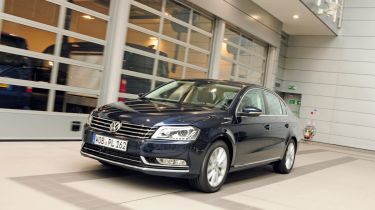Up close with the new Passat
We try out next version of Volkswagen’s ever-popular family and fleet star for size
With more than 15 million sales worldwide over the past 37 years, the Volkswagen Passat has quite a reputation to uphold!
Now a new model has arrived to fight it out with the Ford Mondeo and Skoda Superb – and Auto Express has been given exclusive access to find out if it can live up to the benchmark set by its predecessors.
Video: watch CarBuyer's video review of the VW Passat
[[{"type":"media","view_mode":"content_narrow","fid":"68640","attributes":{"alt":"","class":"media-image"}}]]
Making its global debut at the Paris Motor Show, it’s fair to say that the new model didn’t cause many heads to turn on the VW stand. But away from the artificial glamour of the hall, the Passat looks sharp, thanks to subtly updated styling.
Every panel has been replaced apart from the roof, and it makes for an elegant and understated design. It’s not likely to set pulses racing, but it won’t put off potential customers either.
Head-on, the newcomer is lower and wider than the car it replaces, with clean, angular lines and a narrow grille. Thin foglights, lots of chrome and LED daytime running lights round off what is a classy and subtle look.
Move to the rear and it’s a similar story. The Passat appears wider, while chrome strips and M-shaped LED tail-lights matching those found on the flagship Phaeton also feature.
Used - available now

2022 Mazda
2
16,476 milesManualPetrol1.5L
Cash £13,690
2024 BMW
2 Series Gran Coupe
60,573 milesAutomaticPetrol1.5L
Cash £18,245
2022 Citroen
C3 Origin
8,489 milesManualPetrol1.2L
Cash £12,500
2019 Citroen
C3 Aircross
38,332 milesManualPetrol1.2L
Cash £11,300In fact, the Passat adopts quite a few cues from VW’s range-topping model. As well as the styling, the newcomer has taken steps to re-create the Phaeton’s excellent comfort and refinement. Sound-deadening has been improved and the cabin has been better isolated from wind and road noise, too.
Business and private buyers alike will love the variety of kit available, and the technology on offer wouldn’t look out of place on a car costing twice as much.
For example, you can specify radar-guided cruise control that can brake the car to a standstill, as well as accelerate away, if it detects a rear collision is about to happen.
Then there’s Dynamic Light Assist, which always uses main beam lights, but blocks out an area of light to avoid blinding oncoming traffic.
There are also systems that will park the car for you, try to prevent you from falling asleep at the wheel, inform you of speed limits and help you safely change lane. All very clever – but it’s when you sit in the Passat that it really impresses. Fit and finish are exemplary, with luxurious soft-touch materials used throughout the cabin. An analogue clock and optional ambient interior lighting add a touch of class. Customers can even specify seats with integrated heating, cooling and massage functions.
It’s extremely practical, too. The estate model boasts 513 litres of boot space, rising to 1,641 litres with the back seats down. In the saloon, there’s 565 litres of luggage-carrying capacity – up from 485 litres in the old model. There’s also
a pair of levers in the boot that will fold the rear seats down, boosting space to 1,001 litres. The cleverest feature, though, is a sensor underneath the rear bumper that, providing you have the smart key in your pocket, can open the boot when you wave your foot underneath it.
Under the bonnet, there’s a range of petrol and diesel engines. Kicking off the petrol offerings is a 1.4-litre turbo TSI with 120bhp, but a 1.8-litre 158bhp unit and a 2.0-litre TSI engine with 207bhp are also available. When fitted with stop-start and brake energy regeneration, the 1.4-litre TSI produces only 138g/km of CO2.
The oil-burners start with a 1.6-litre TDI, which when combined with BlueMotion tweaks, including stop-start and brake energy regeneration, can achieve 68.8mpg and delivers CO2 emissions of just 109g/km. There’s also a 2.0-litre diesel engine that can be ordered in two states of tune – 138bhp and 168bhp.
Expect 0-62mph times to range from around 12 seconds in the 1.6-litre TDI BlueMotion to just under eight seconds in the 2.0-litre TSI. The engines can be paired with VW’s DSG double-clutch gearbox, with the exception of the BlueMotion model, which must be specified with a six-speed manual gearbox.
The company is keen to improve the Passat’s dynamics, too. Although it’s based on the same platform as the old model, engineers will likely fit the XDS traction control system from the Golf GTI to more powerful models. This hi-tech set-up mimics a limited-slip differential to reduce understeer and improve traction.
There’s no word on pricing just yet, but base ‘S’ models are set to start at around £18,000 and come as standard with a leather multifunction steering wheel, alloy wheels, air-conditioning and an iPod connection.
In addition to that, ‘SE’ models will get a digital radio, Bluetooth and fatigue detection. Sport variants will top the range. Estate and saloon models will go on sale in the middle of October with the first models being delivered in January 2011. R-Line models, featuring sporty styling upgrades, will be unveiled later in the year.







